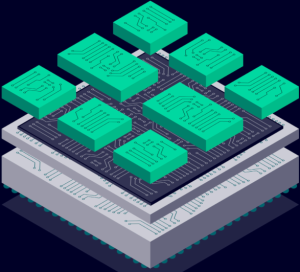Future of 3D-Printed Integrated Circuits: Opportunities and Challenges
Introduction
The world of electronics is entering an era of rapid transformation. The semiconductor industry has long relied on traditional silicon-based fabrication methods, which demand billion-dollar facilities, advanced photolithography, and highly controlled environments. However, with the rise of 3D printing technologies, the idea of manufacturing integrated circuits (ICs) through additive methods has gained significant attention. While still in its early stages, 3D-printed integrated circuits (ICs) represent a disruptive force that could reshape electronics design, production, and accessibility.

Image Courtesy : Siemens EDA
The Promise of 3D-Printed ICs
3D printing, or additive manufacturing, builds objects layer by layer, offering flexibility and material efficiency. Applied to IC fabrication, this approach enables the direct printing of conductive, dielectric, and semiconducting layers without relying on conventional photolithography.
The advantages include:
-
On-Demand Customization: Circuits can be designed and printed for specialized applications, reducing lead times.
-
Cost Reduction: Eliminates the need for large-scale fabs, opening opportunities for smaller companies and research labs.
-
Rapid Prototyping: Engineers can quickly test new designs before moving to mass production.
-
Heterogeneous Integration: Ability to combine different materials—such as organic semiconductors, graphene, or flexible substrates—into a single chip.
-
Sustainability: Less waste compared to subtractive manufacturing methods.
Current Progress and Applications
Researchers and startups have already demonstrated working prototypes of printed transistors, sensors, and simple logic circuits. Some applications gaining momentum include:
-
Wearable and Flexible Electronics – Smart textiles and medical monitoring devices.
-
IoT Devices – Low-cost, energy-efficient chips for sensor networks.
-
Aerospace and Defense – On-site manufacturing of mission-specific ICs.
-
Healthcare – Printed bioelectronics and neural interface circuits for personalized medicine.
These applications highlight the niche potential of 3D-printed ICs, particularly where traditional silicon chips are either too rigid, expensive, or slow to adapt.
Challenges To Overcome
Despite its potential, several hurdles remain before 3D-printed ICs can rival conventional silicon-based chips:
-
Performance Gap: Printed semiconductors lack the speed, density, and efficiency of nanoscale CMOS technology.
-
Material Limitations: Printable semiconductors and conductive inks are still under development, with performance far behind crystalline silicon.
-
Scalability Issues: Printing nanoscale features with high yield remains a major challenge.
-
Reliability Concerns: Long-term durability and stability of printed circuits must be proven for industrial adoption.
-
Standardization: The absence of established design and fabrication standards hinders commercialization.
Future Outlook
The future of 3D-printed ICs will likely unfold in stages:
-
Short-Term (Next 5 Years): Growth in low-power, flexible, and niche applications such as IoT sensors, biomedical devices, and smart packaging.
-
Mid-Term (5–10 Years): Hybrid systems where conventional silicon chips are combined with 3D-printed interconnects, packaging, or flexible extensions.
-
Long-Term (Beyond 10 Years): Potential breakthroughs in printable semiconductors and nanoscale printing could enable competitive performance with traditional silicon ICs.
Ultimately, 3D-printed ICs will not replace conventional fabs in high-performance computing. Instead, they will complement the semiconductor ecosystem by enabling localized, on-demand, and application-specific electronics. This democratization of chip manufacturing could spark new innovations in healthcare, aerospace, energy, and consumer electronics.
conclusion
The future of 3D-printed ICs lies in specialized markets rather than mainstream processors. As materials science and additive manufacturing techniques advance, 3D printing could unlock a new era of accessible, customizable, and sustainable electronics.